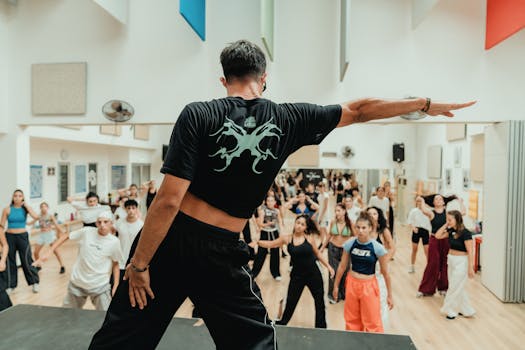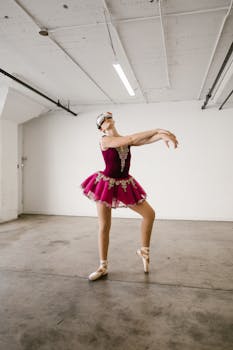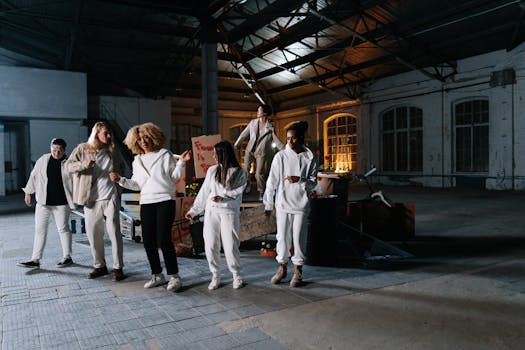Annonces
La danse est une forme d'expression vibrante qui capture l'expérience humaine à travers les cultures. En tant qu'art, elle allie rythme, mouvement et narration. Comprendre la conception de la danse révèle comment les structures intentionnelles enrichissent les performances et captivent le public.
Qu'il s'agisse d'un spectacle de ballet ou d'une représentation contemporaine, la conception de la danse joue un rôle crucial dans son efficacité. De la chorégraphie à la mise en scène, chaque élément contribue à l'expérience globale. En explorant les détails complexes de la conception de la danse, nous pouvons apprécier son importance dans diverses représentations.
Cet article explore les composantes essentielles de la conception de la danse, offrant un aperçu de la chorégraphie, de la scénographie, des costumes, de l'éclairage et de l'interaction avec le public. Ces éléments non seulement subliment le spectacle, mais renforcent également l'engagement émotionnel et créent des impressions durables.
Comprendre la chorégraphie
La chorégraphie est au cœur de la création chorégraphique, englobant les motifs et les séquences suivis par les danseurs. Cet art traduit émotions et histoires en mouvement. Un chorégraphe tisse des liens entre différentes techniques de danse pour créer une œuvre cohérente.
Une chorégraphie efficace prend en compte la musique, l'ambiance et l'espace physique. Elle permet aux danseurs d'exprimer leur individualité tout en conservant une vision unifiée. Cette dynamique donne naissance à des performances captivantes qui trouvent un écho auprès du public.
Annonces
De plus, la chorégraphie peut varier considérablement selon les genres de danse. Par exemple, le ballet met l'accent sur la précision et la forme, tandis que la danse contemporaine privilégie les lignes et l'expression émotionnelle. Comprendre ces distinctions est essentiel pour apprécier le talent artistique impliqué.
De plus, les danseurs doivent s'entraîner intensivement pour incarner une chorégraphie authentique. Les répétitions se concentrent sur la mémoire musculaire, le rythme et la synchronisation. L'effort investi dans les répétitions améliore la qualité globale de la performance, faisant de la chorégraphie un travail collaboratif.
En résumé, la chorégraphie ne se résume pas à des mouvements de danse ; c'est un art complet qui implique un agencement réfléchi des mouvements pour raconter une histoire. Cette base ouvre la voie à des performances captivantes.
Annonces
Le rôle de la scénographie
La scénographie influence considérablement la perception de la danse. Une scène bien conçue met en valeur le récit des interprètes, créant une ambiance et une atmosphère propices à la création. Elle transforme un simple espace au sol en un paysage captivant.
Une scénographie efficace prend en compte des éléments tels que le décor, les accessoires et l'agencement spatial. Un arrière-plan adapté peut susciter des émotions et contextualiser le spectacle. De plus, les accessoires peuvent être intégrés à la chorégraphie, ajoutant ainsi des couches narratives.
Les couleurs et les textures utilisées dans la scénographie amplifient l'impact visuel. Des teintes douces et discrètes peuvent créer une atmosphère intime, tandis que des couleurs vives peuvent dynamiser une représentation. Cet aspect visuel est essentiel pour éveiller les sens du public.
De plus, la scénographie doit s'adapter parfaitement à la chorégraphie. Les danseurs ont besoin d'un espace suffisant pour exécuter leurs mouvements sans contraintes. Une conception bien pensée favorise l'harmonie entre les danseurs et leur environnement.
En conclusion, la scénographie est plus qu'une question d'esthétique ; c'est un outil puissant qui enrichit la narration en danse. Son intégration à la chorégraphie permet aux interprètes de créer des expériences immersives pour le public.
Costumes pour un impact
Les costumes sont essentiels à la conception d'une danse, répondant à des objectifs à la fois pratiques et esthétiques. Une tenue appropriée permet une liberté de mouvement tout en reflétant le caractère et les thèmes du spectacle. Des costumes adaptés peuvent grandement mettre en valeur le portrait d'un danseur.
Le choix des costumes implique une attention particulière aux matières, aux couleurs et aux styles. Les tissus doivent être légers et souples, permettant une grande liberté de mouvement. De plus, les couleurs doivent s'harmoniser avec l'ambiance, améliorant la visibilité et la connexion émotionnelle.
De plus, les costumes peuvent symboliser des traits de caractère ou des thèmes narratifs. Par exemple, une robe fluide peut représenter la grâce, tandis que des pièces anguleuses et pointues peuvent symboliser le conflit. Cette dimension supplémentaire enrichit la compréhension du spectacle par le public.
De plus, les costumes doivent être légers et faciles à changer pour les représentations comportant plusieurs pièces. Des changements rapides nécessitent une conception et une planification réfléchies, garantissant une performance fluide et captivante.
En résumé, les costumes font partie intégrante de la conception de la danse. Ils allient fonctionnalité et expression artistique, permettant aux danseurs de raconter leurs histoires avec plus d'efficacité. Des costumes soigneusement conçus rehaussent l'impact global du spectacle.
Les essentiels de la conception d'éclairage
La conception lumière joue un rôle crucial dans l'expérience globale des spectacles de danse. Elle permet de créer une ambiance, de mettre en valeur les performances et d'attirer l'attention du public. Sans un éclairage efficace, même la chorégraphie la plus aboutie peut échouer.
La couleur et l'intensité de l'éclairage influencent considérablement le récit visuel. Les teintes chaudes peuvent créer une atmosphère intime, tandis que les tons froids peuvent évoquer un sentiment de distance ou de tristesse. Cette manipulation peut renforcer l'engagement émotionnel.
De plus, l'éclairage contribue à définir l'espace sur scène. Des projecteurs peuvent attirer l'attention sur les performances solo, tandis que des éclairages plus larges mettent en valeur les pièces d'ensemble. Un éclairage efficace soutient la chorégraphie en fournissant des repères aux danseurs.
De plus, le timing des changements d'éclairage est crucial. Des transitions bien synchronisées peuvent se synchroniser avec les rythmes musicaux ou les mouvements, renforçant ainsi la fluidité générale de la performance. Cette relation entre danse et lumière peut être fascinante.
En conclusion, la conception lumière est essentielle pour des spectacles de danse dynamiques. Sa capacité à amplifier et à diriger l'attention renforce l'aspect narratif, ce qui en fait un élément indispensable de la conception de la danse.
Interaction et engagement du public
Créer un lien avec le public est essentiel au succès de tout spectacle de danse. La conception chorégraphique doit s'attacher à captiver le public et à lui donner le sentiment d'être partie prenante de l'expérience. L'interaction favorise un lien plus profond.
Les expériences immersives constituent une méthode d'engagement du public. Les performances impliquant le public, visuellement ou de manière interactive, peuvent créer des moments mémorables. Cette approche brise les barrières entre artistes et spectateurs.
Un autre aspect consiste à créer des thèmes auxquels le public peut s'identifier et qui résonnent avec ses émotions. En explorant des émotions et des expériences universelles, les chorégraphes captivent le public et donnent du sens à la performance. Un voyage émotionnel partagé renforce l'engagement.
De plus, les spectacles peuvent intégrer des mécanismes de feedback, permettant au public d'exprimer ses impressions après le spectacle. Cet engagement peut donner lieu à des discussions et des réflexions, enrichissant ainsi la perception du spectacle et favorisant le sentiment d'appartenance.
En résumé, l'interaction avec le public est un aspect essentiel de la conception d'un spectacle de danse. En réfléchissant à la manière de créer un lien avec les spectateurs, les performances peuvent laisser un impact durable et créer une expérience mémorable pour tous les participants.
Intégration de la technologie dans la conception de la danse
La conception de la danse moderne intègre de plus en plus la technologie pour enrichir les performances. Des innovations telles que le mapping vidéo, la réalité virtuelle et les applications interactives redéfinissent l'expérience du public en danse. Cette intégration ouvre de nouvelles perspectives créatives.
Le mapping vidéo permet de transformer les arrière-plans et de créer des visuels dynamiques qui complètent la chorégraphie. Cette intégration ajoute de la profondeur et du contexte, augmentant ainsi la charge émotionnelle d'une performance. Elle permet aux chorégraphes d'expérimenter la narration visuelle.
De plus, les technologies interactives peuvent impliquer le public de manière unique. Par exemple, les applications permettant aux spectateurs de choisir l'angle de prise de vue peuvent créer une expérience personnalisée, les plongeant plus profondément dans le récit du spectacle. Cette interaction favorise l'engagement.
De plus, la technologie peut faciliter la collaboration entre les entreprises. Les plateformes numériques permettent aux chorégraphes, danseurs et designers d'échanger des idées et de partager des ressources, améliorant ainsi les flux de création. Cette connectivité peut donner lieu à des performances innovantes.
En conclusion, la technologie joue un rôle transformateur dans la conception de spectacles de danse. Elle permet des présentations innovantes et renforce l'engagement du public, marquant ainsi une nouvelle ère dans le paysage créatif de la danse.
Réflexions finales sur la conception de la danse
Comprendre la conception de la danse implique d'apprécier ses diverses composantes, chacune contribuant au succès d'une représentation. Chorégraphie, scénographie, costumes, éclairage, interaction avec le public et technologie s'harmonisent harmonieusement.
Chaque élément renforce l'aspect narratif, permettant aux danseurs de transmettre efficacement leurs émotions. Une performance bien conçue captive le public et crée des liens qui résonnent au-delà de la scène.
À mesure que la danse évolue, l'exploration de ces aspects devient cruciale, tant pour les interprètes que pour le public. Le dynamisme de la création chorégraphique reflète un paysage culturel en constante évolution, repoussant sans cesse les limites de la créativité.
En résumé, une compréhension approfondie de la conception de la danse enrichit notre appréciation des performances, soulignant leur complexité et leur valeur artistique. L'intégration de ces éléments peut enrichir la création et l'expérience.
En fin de compte, la création de danse vise à tisser des liens, à raconter des histoires et à créer des moments partagés. Elle nous invite tous à partager le magnifique langage du mouvement.



